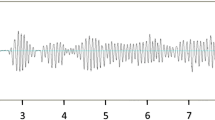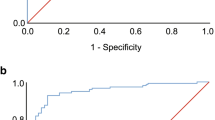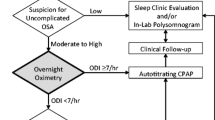Abstract
We assessed the accuracy of a wrist-worn device WatchPAT 200 for the diagnosis of obstructive sleep apnea (OSA) and sleep and wakefulness indicators compared to standard polysomnography (PSG) using American Academy of Sleep Medicine (AASM) criteria. Twenty-eight adults with suspected OSA underwent a standard in-hospital PSG while wearing a WatchPAT 200. PSG events were manually scored using AASM criteria; WatchPAT 200 data were collected and analyzed by an automatic algorithm. The accuracy of WatchPAT 200 algorithm in apnea hypopnea index (AHI) and sleep-wake detection was compared to standard PSG methodology. The study population consisted of 21 males and 7 females, mean age of 47.45 ± 13.46 years, and mean body mass index of 29.99 ± 5.74 kg/m2. For AHI, the mean PSG score for events per hour was 23.00 ± 21.55 compared to a mean score of 25.99 ± 19.09 for WatchPAT (r = 0.92, P < 0.001). The agreement of the sleep-wake assessment based on 30-s bins between the PSG and the WatchPAT was 89 ± 6 %. WatchPAT 200 detected OSA based on AHI with comparable accuracy, and provided a reasonably accurate estimation of sleep and wakefulness in patients with OSA on an epoch-by-epoch basis.



Similar content being viewed by others
References
Shahar E, Whitney CW, Redline S et al (2001) Sleep-disordered breathing and cardiovascular disease: cross-sectional results of the sleep heart health study. Am J Respir Crit Care Med 163:19–25
Peppard PE, Young T, Palta M, Skatrud J (2000) Prospective study of the association between sleep-disordered breathing and hypertension. N Engl J Med 342:1378–1384
Kushida CA, Littner MR, Morgenthaler T et al (2005) Practice parameters for the indications for polysomnography and related procedures: an update for 2005. Sleep 28:499–521
Andrew LC, Richard AF, June MF (1997) Practice parameters for the indications for polysomnography and related procedures. Polysomnography task force, American sleep disorders association standards of practice committee. Sleep 20:406–422
White DP, Gibb TJ, Wall JM, Westbrook PR (1995) Assessment of accuracy and analysis time of a novel device to monitor sleep and breathing in the home. Sleep 18:115–126
Pang KP, Gourin CG, Terris DJ (2007) A comparison of polysomnography and the watchpat in the diagnosis of obstructive sleep apnea. Otolaryngol Head Neck Surg 137:665–668
Choi JH, Kim EJ, Kim YS et al (2010) Validation study of portable device for the diagnosis of obstructive sleep apnea according to the new AASM scoring criteria: watchpat 100. Acta Otolaryngol 130:838–843
Ayas NT, Pittman S, MacDonald M, White DP (2003) Assessment of a wrist-worn device in the detection of obstructive sleep apnea. Sleep Med 4:435–442
Herscovici S, Pe’er A, Papyan S, Lavie P (2007) Detecting REM sleep from the finger: an automatic REM sleep algorithm based on peripheral arterial tone (pat) and actigraphy. Physiol Meas 28:129–140
Weiss JW, Remsburg S, Garpestad E, Ringler J, Sparrow D, Parker JA (1996) Hemodynamic consequences of obstructive sleep apnea. Sleep 19:388–397
Zou D, Grote L, Eder DN, Peker Y, Hedner J (2004) Obstructive apneic events induce alpha-receptor mediated digital vasoconstriction. Sleep 27:485–489
Redline S, Kapur VK, Sanders MH et al (2000) Effects of varying approaches for identifying respiratory disturbances on sleep apnea assessment. Am J Respir Crit Care Med 161:369–374
Schnall RP, Shlitner A, Sheffy J, Kedar R, Lavie P (1999) Periodic, profound peripheral vasoconstriction–a new marker of obstructive sleep apnea. Sleep 22:939–946
Pillar G, Bar A, Shlitner A, Schnall R, Shefy J, Lavie P (2002) Autonomic arousal index: an automated detection based on peripheral arterial tonometry. Sleep 25:543–549
Pillar G, Bar A, Betito M, Schnall RP, Dvir I, Sheffy J, Lavie P (2003) An automatic ambulatory device for detection of AASM defined arousals from sleep: the wp100. Sleep Med 4:207–212
Lavie P, Shlitner A, Sheffy J, Schnall RP (2000) Peripheral arterial tonometry: a novel and sensitive non-invasive monitor of brief arousals during sleep. Isr Med Assoc J 2:246–247
Lavie P, Schnall RP, Sheffy J, Shlitner A (2000) Peripheral vasoconstriction during REM sleep detected by a new plethysmographic method. Nat Med 6:606
Hedner J, Pillar G, Pittman SD, Zou D, Grote L, White DP (2004) A novel adaptive wrist actigraphy algorithm for sleep-wake assessment in sleep apnea patients. Sleep 27:1560–1566
Dvir I, Adler Y, Freimark D, Lavie P (2002) Evidence for fractal correlation properties in variations of peripheral arterial tone during REM sleep. Am J Physiol Heart Circ Physiol 283:H434–H439
Bresler M, Sheffy K, Pillar G, Preiszler M, Herscovici S (2008) Differentiating between light and deep sleep stages using an ambulatory device based on peripheral arterial tonometry. Physiol Meas 29:571–584
Rice TB, Dunn RE, Lincoln AE et al (2010) Sleep-disordered breathing in the national football league. Sleep 33:819–824
Potasz C, Juliano ML, Varela MJ, Ferraz PG, Carvalho LB, Prado LF, Prado GF (2010) Prevalence of sleep disorders in children of a public hospital in Sao Paulo. Arq Neuropsiquiatr 68:235–241
Plywaczewski R, Bednarek M, Jonczak L, Zielinski J (2008) Sleep-disordered breathing in a middle-aged and older polish urban population. J Sleep Res 17:73–81
Kim J, In K, You S et al (2004) Prevalence of sleep-disordered breathing in middle-aged Korean men and women. Am J Respir Crit Care Med 170:1108–1113
Khazaie H, Najafi F, Rezaie L, Tahmasian M, Sepehry AA, Herth FJ (2011) Prevalence of symptoms and risk of obstructive sleep apnea syndrome in the general population. Arch Iran Med 14:335–338
Goring K, Collop N (2008) Sleep disordered breathing in hospitalized patients. JCSM Off Publ Am Acad Sleep Med 4:105–110
Goldstein NA, Abramowitz T, Weedon J, Koliskor B, Turner S, Taioli E (2011) Racial/ethnic differences in the prevalence of snoring and sleep disordered breathing in young children. JCSM Off Publ Am Acad Sleep Med 7:163–171
Chuang LP, Hsu SC, Lin SW, Ko WS, Chen NH, Tsai YH (2008) Prevalence of snoring and witnessed apnea in Taiwanese adults. Chang Gung Med J 31:175–181
Bixler EO, Vgontzas AN, Lin HM (2009) Sleep disordered breathing in children in a general population sample: prevalence and risk factors. Sleep 32:731–736
Johns MW (1991) A new method for measuring daytime sleepiness: the Epworth sleepiness scale. Sleep 14:540–545
Iber C, Ancoli-Israel S, Chesson AJ, Quan SF (2007) The AASM manual for the scoring of sleep and associated events: rules, terminology and technical specifications. American Academy of Sleep Medicine, Westchester
Ayas NT, Pittman S, Malhotra A (2001) Do indices of autonomic arousal predict sleepiness better than standard polysomnographic measures? Sleep Breath Schlaf Atm 24:A91
Bar A, Pillar G, Dvir I, Sheffy J, Schnall RP, Lavie P (2003) Evaluation of a portable device based on peripheral arterial tone for unattended home sleep studies. Chest 123:695–703
Tauman R, O’Brien LM, Mast BT, Holbrook CR, Gozal D (2004) Peripheral arterial tonometry events and electroencephalographic arousals in children. Sleep 27:502–506
Wang D, Wong KK, Dungan GC 2nd, Buchanan PR, Yee BJ, Grunstein RR (2008) The validity of wrist actimetry assessment of sleep with and without sleep apnea. JCSM Off Publ Am Acad Sleep Med 4:450–455
Pittman SD, Ayas NT, MacDonald MM, Malhotra A, Fogel RB, White DP (2004) Using a wrist-worn device based on peripheral arterial tonometry to diagnose obstructive sleep apnea: in-laboratory and ambulatory validation. Sleep 27:923–933
Penzel T, Kesper K, Pinnow I, Becker HF, Vogelmeier C (2004) Peripheral arterial tonometry, oximetry and actigraphy for ambulatory recording of sleep apnea. Physiol Meas 25:1025–1036
Hedner J, White DP, Malhotra A, Herscovici S, Pittman SD, Zou D, Grote L, Pillar G (2011) Sleep staging based on autonomic signals: a multi-center validation study. JCSM Off Publ Am Acad Sleep Med 7:301–306
Yilmaz B, Asyali MH, Arikan E, Yetkin S, Ozgen F (2010) Sleep stage and obstructive apneaic epoch classification using single-lead ECG. Biomed Eng Online 9:39
Basner M, Griefahn B, Muller U, Plath G, Samel A (2007) An ecg-based algorithm for the automatic identification of autonomic activations associated with cortical arousal. Sleep 30:1349–1361
Acknowledgments
This paper is supported by subject Otology diseases of tissue repair and functional reconstruction research, grant No. 2012BAI12B01.
Conflict of interest
The authors declare that there is no conflict of interest.
Author information
Authors and Affiliations
Corresponding author
Rights and permissions
About this article
Cite this article
Weimin, L., Rongguang, W., Dongyan, H. et al. Assessment of a portable monitoring device WatchPAT 200 in the diagnosis of obstructive sleep apnea. Eur Arch Otorhinolaryngol 270, 3099–3105 (2013). https://doi.org/10.1007/s00405-013-2555-4
Received:
Accepted:
Published:
Issue Date:
DOI: https://doi.org/10.1007/s00405-013-2555-4




